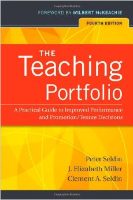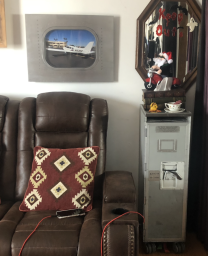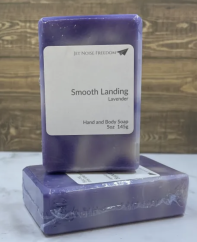
Why?
"A teaching portfolio is a factual description of a professor's teaching strengths and accomplishments. It includes documents and materials that collectively suggest the scope and quality of a professor's teaching performance." (Seldin, Miller, & Seldin, 2010, p. 4)
Provide the evidence...
Triangulation of data - Teaching effectiveness:
1. End of course student opinion surveys
2. Partners in teaching
3. Pre/Post student learning data (SoTL)
Clarify expectations - Faculty handbook:
1. Faculty expectations
2. Tenure and promotion application format
Why>What
- reflect on your underlying teaching philosophy
- describe the strategies and methodologies that flow from that reflection - why you do what you do
- select documents and materials that provide the HARD EVIDENCE of your teaching activities and accomplishments
Collaborate
Provide supporting documentation for every claim you make
Be sure to cross-reference between narrative and appendices
Include specifics regarding efforts to improve teaching (program titles, facilitator, locations, dates...)
|
To provide evidence for use in personnel decisions Rational and equitable basis for promotion and tenure |
To improve teaching performance Process of reflecting on work and creating collection of documents and materials stimulates professors to reconsider policies and activities, rethink strategies and methodologies, revise priorities, and plan for future
|
|
Table of contents
|
Table of contents
|
A portfolio is a valuable aid in professional development:
- The level of personal investment in time, energy, and commitment is high (since faculty prepare their own portfolio) and that is a necessary condition for change
- Preparation of the portfolio stirs many professors to reflect on their teaching in an insightful, refocused way
- It is grounded in discipline-based pedagogy, that is, the focus is on teaching a particular subject to a particular group of students at a particular time in a particular institution.
The items chosen for the portfolio are based on a combination of availability of supporting materials, the nature of the portfolio, the faculty position, the discipline, and the importance assigned by the faculty member to different items.
Three broad categories:
- Material from oneself
- Statement of teaching responsibilities
i.Course titles
ii.Catalogue numbers
iii.Average enrollments
iv.Graduate/undergraduate course
v.Required/elective
- Teaching philosophy – philosophy of teaching and learning that drives professor’s classroom performance
i.What do I believe about the role of the teacher?
ii.What do I believe about the role of the student?
iii.Why do I teach?
iv.What does good teaching mean to me?
v.What can my students expect from me?
- Teaching methodologies
i.Why do I choose the teaching strategies and methods I use?
ii.How would I describe my particular teaching style?
iii.What do I do in the classroom and outside it?
iv.How do I assess student learning?
v.What kind of feedback do I give to students?
- Description of teaching materials
i.Samples are placed in the appendix
ii.Highlights are included in the narrative
iii.The two are cross-referenced
iv.Applications of computer technology, study guides, case studies, handouts, manuals
v.How do these materials enhance my teaching?
vi.In what ways have they changed in recent years?
vii.How do I know these changes are for the better?
viii.What kind of student feedback do I have about the effectiveness of these teaching materials?
- Curricular revisions
i.Have I introduced new applications of technology?
ii.Changed course objectives?
iii.Used new materials?
iv.Added or dropped guest speakers?
v.Field trips?
vi.Laboratory work?
vii.Have I developed a new course?
viii.Revised a course?
ix.Team-taught a course?
- Instructional innovations
i.What new approaches have I introduced in teaching my courses?
ii.Which ones worked well?
iii.Why were they successful?
iv.Which didn’t work well?
v.Why didn’t they work?
vi.How could they be changed so they would be more successful next time?
- Representative course syllabi
i.Samples placed in appendix
ii.Highlights appear in narrative
iii.He two are cross-referenced
iv.What does this syllabus say about my teaching and learning beliefs?
v.What do I want it to say?
vi.What does it say about the course and my way of teaching it?
vii.Is it a learning-centered syllabus?
viii.Does it detail course content and objectives, teaching methodology, readings, and homework assignments in the way I want it to?
- Documentation of teaching improvement activities
i.Samples of certificates of attendance placed in appendix
ii.Reference is made in narrative
iii.The two are cross-referenced
iv.Which faculty development workshops and conferences have I attended?
v.How am I applying what I learned from those programs?
vi.What specific steps have I taken to improve my teaching?
vii.How have I responded to suggestions for improvement that have come from students?
- Teaching goals – short and long term
i.Look ahead
ii.Crystallize thinking about possible projects and activities to continue development as a teacher
iii.What teaching goals have I been unable to attain in the past that I would like to pursue now?
iv.Why are they important to me?
v.How can my department or institution help me achieve those goals?
vi.What kind of resources help (people, money, space, time) do I need to achieve those goals?
- Material from others
- Student course evaluations
i.Samples of certificates of attendance placed in appendix
ii.Reference is made in narrative
iii.The two are cross-referenced
iv.Are all claims made in the narrative about student ratings supported by evidence in the appendix?
v.Are there any special circumstances that affected the ratings?
vi.Is the vast majority of the student feedback current or from the recent past (3-5 years)?
vii.Are student evaluation data included from each class that is regularly taught?
viii.Are data from all pivotal questions included?
- Colleague review of teaching materials
i.Excerpts from course syllabi, assignments, reading lists, tests, etc. are placed in the narrative
ii.Samples are placed in appendix
iii.Reference is made in narrative
iv.Are excerpts included in the narrative that tie in with my teaching philosophy or methodology?
v.What do these teaching aids say about my teaching and learning beliefs?
vi.What is significant about each?
vii.In specific terms, how do they help students learn?
- Classroom observation by faculty colleagues or administrators
i.Excerpts placed in narrative
ii.Samples are placed in appendix
iii.Reference is made in narrative
iv.Is the observation report dated and signed by the observer?
v.Are any excerpts included in the narrative that tie in with my philosophy of teaching or pedagogical methodology?
vi.Did any special circumstances (e.g. room to noisy, large, small, cold, hot) interfere with teaching and learning during the observation?
- Documentation of teaching improvement activities
i.Samples of certificates of attendance placed in appendix
ii.Reference made in narrative
iii.The two are cross-referenced
iv.Which faculty development seminars of workshops have I attended?
v.How am I applying what I learned from these programs in my teachings?
vi.What evidence do I have of growth or change in my teaching?
vii.How have I responded to students’ suggestions for improvement?
- Teaching honors and other recognition
i.Teaching honors or other recognition from colleagues, students, administrators, or alumni (e.g. distinguished teaching award, student advising award, teacher of the year designation)
ii.Place certificates of achievement, award letters, and photographs in the appendix
iii.Which teaching honors or other recognition have I won?
iv.Who selected me for this achievement: peers, students, or alumni?
v.On what basis was I selected?
vi.Have there been setbacks or disappointments that later served as the foundation of any of these honors?
- Products of good teaching and student learning
- A record of students who succeed in advanced study in the field
i.Student list of those who have gone on to success in higher-level courses or are now employed in the field
ii.Which of my recent students have gone on to advanced study in my discipline?
iii.Which are employed in the field?
iv.Do I have evidence of my influence on student career choice or graduate school admission?
v.Have I helped any students secure employment?
- Student scores on examinations before and after the course
i.Focus is on performance of entire class
ii.Are all claims of student learning in the narrative supported by evidence in the appendix?
iii.Are the data showing test score differences in examinations from multiple courses?
iv.Are there any circumstances that interfered with student learning?
v.Are there changes that I can make in my teaching that could increase student learning?
- Successive drafts of student papers
i.Showing improvement as a result of faculty member’s comments or guidance
ii.Included in narrative
iii.Cross-referenced in appendix
iv.Have I included my written comments suggesting how samples of student work might be improved, along with student work itself?
v.Does it reflect graded student work that represents different levels of quality: excellent, good, average, poor?
vi.Do the graded student assignments reflect my efforts to direct development of critical thinking skills or written communication skills?
- Student participations on conference presentations prepared under the direction of the faculty member
i.Especially relevant to faculty who teach on graduate level
ii.Present as list of student publications and conference presentations prepared under guidance and direction of professor
iii.What was my role with each student listed: to provide direction or support or to serve as a coauthor or copresenter?
iv.Have I included appropriate citations in the narrative and appropriate evidence in the appendix file?
- The appendix
- Best not to engage in overkill
- Should us judiciously chosen evidence that adequately supports narrative
- For non print media narrative should mention they are available for review in a designated location
- One’s approach to this section should be:
i.Reflect on your underlying teaching philosophy
ii.Describe the strategies and methodologies that flow from that reflection (why you do what you do)
iii.Select documents and materials that provide the hard evidence of your teaching activities and accomplishments
- Examples of evidence in the appendix:
i.Student ratings of instruction
ii.Syllabi
iii.Classroom observation reports
iv.Samples of graded student work
v.Invitations to speak at conference or another institution on teaching one’s discipline
vi.Copies of course assignments, study guides, exams, and reading lists
vii.Record of student scores on tests
viii.Examples of your contribution to curriculum design and course development
ix.Confirmation of your participation in teaching improvement activities
x.Teaching awards and other recognition of your teaching accomplishments
- The mechanics
- Typical portfolio length
i.Narrative 8-12 pages double-spaced
ii.Followed by tabbed appendix files
iii.Material from oneself 3-5 pages
iv.Material from others 3-4 pages
v.Products of good teaching and student learning 2-3 pages
- Portfolio preparation time
i.Depends
ii.If annual reports are made then easier so 10-12 hours
iii.If not then 15-18 hours
Preparing the Teaching Portfolio
3 crucial cornerstones:
- The need to discuss expectations
- Department and institution expectations in terms of teaching
- Evidence of successful performance – quantity and quality – and how much
- Appropriate and effective ways to report evidence
- Getting started with portfolios
- Group of faculty develop general standards of good teaching
- Enough flexibility to accommodate diverse approaches
- Obtain public, top-level administrative support
- Start small
- Involve institution’s / department’s most respected faculty
- Rely on faculty volunteers
- Keep everyone informed
- Field-test portfolio process
- Permit room for individual differences
- Allow 1-2 years for acceptance and implementation
- Gaining acceptance of the concept
- Present portfolio in candid, complete, and clear way to everyone
- Professors must have significant hand in development and operation
- Encourage collaboration – portfolio mentor
- Include selective information – not exhaustive compilation – to address the why and what of teaching
Steps to creating a teaching portfolio
- Planning
- Purpose
- Audience
- Summarize teaching responsibilities
- Courses currently taught
- Advising
- Describe your approach to teaching
- 2 – 2 ½ reflective statement
- Teaching philosophy, objectives, methodologies
- Select items for the portfolio
- Summary of teaching responsibilities
- Teaching philosophy
- Syllabi
- Other evidence of teaching effectiveness
- Prepare statements on each item
- Activities
- Initiatives
- Accomplishments
- Student portfolios focused on skill development
- Order the items
- Sequence of statements about accomplishments in each area is determined by their intended purpose
- Compile the supporting data
- Evidence is not included in narrative but placed in appendix
- Present the portfolio
- In a unified container – three-ring binder – 2 ½ inch with sleeves in front and spine – and tabs to organize with computer-generated stick on labels
- Do not use plastic sleeves but instead three-hole punch every page
- Incorporate the portfolio into the curriculum vitae
- Portfolio is inserted into CV under “teaching”
The Importance of Collaboration
- Working with a mentor
- Department chair
- Teaching improvement specialist
- Colleague – this is best!
- Someone who can motivate while maintaining objective perspective
- Self-monitoring
- Not the ideal but still doable
Suggestions for improving the teaching portfolio
- House the portfolio in a binder with tabs for appendices
- Include the date of the portfolio
- Include a detailed table of contents
- Include a list of appendix items
- Cross reference the narrative to the appendix – “See Appendix A for copies of syllabi”
- Number the pages in the portfolio
- Bring the teaching philosophy statement to life – reflective, straightforward, well-organized statement, 1-2 pages, first-person approach
- Describe how the philosophy is translated into action – how you conduct classes, develop instructional resources, grade performance, advise students, climate established
- Explain the evidence in the portfolio – why the changes and perhaps students emailed comments to them
- Consider including the occasional disappointment in teaching or learning
- Include specific information, not generalities – dates, names, programs, titles of courses – “Ninety-four percent of the seventy-six students in my Microeconomics course (fall 2010) states that they would recommend that their friends take my class” – “My department chair, Hugh Downey, observed my Introduction to Finance course on November 1, 201, and reported that I was ‘well-prepared, that my students were fully engaged, and that the content was covered in a thorough and interesting way.’ (See Appendix A for the chair’s complete observation report.)”
- Format the narrative for reader interest – boldface, italics, bullet points, charts, graphs – avoid long paragraphs
- Enhance the student evaluation section
- Limit the number of student or colleague comments – 2-3 comments – “The discussion method that Professor Abel used was especially effective in engaging us with the material.” – “Professor Abel’s use of directed discussion was effective, engaging and appropriate for the Introduction to Psychology class that I observed on February 3, 2010.”
- Include names and positions of people to whom you refer – “My department chair, Patricia Streim, reviewed the teaching materials from my Introduction to Creative Arts course on March 1, 2010. Appendix C contains her report. It states (in part) that the materials were ‘outstanding, clear, thoughtful, and student-friendly.’ ”
- Seek coherence among portfolio sections
- Make bulky items available on request
- Update the portfolio each year
Evaluating the teaching portfolio
- Key requirements
- Practicality – should not require inordinate amount of time or energy to read and evaluate
- Relevance
- Acceptability
- The importance of mandated portfolio items – to allow for fair comparison between faculty
- Avoiding pitfalls in the evaluation of teaching portfolios
- DO NOT assume that everyone must teach in the same way
- DO NOT assume that standards and ratings will be the same across academic disciplines and institutions
- General items to consider in evaluating portfolios
- All core items e.g. student ratings
- Evidence that academic institutional goals are met
- Evidence of accomplishment
- Data from past 4 years
- Three areas of documentation (self-others-student learning) balanced
- Teaching consistent with departmental and institutional priorities
- Reflective statement consistent with syllabus and student evaluations/peer observations
- Meets length requirements
- Evidence of peer evaluation
- Products/outcomes show successful teaching
- Efforts of improved performance over time
- Ratings on all common core questions must be included
- Teaching responsibilities match job responsibilities
- Profiles individual style
- Consistency between teaching philosophy and actions in classroom
- All claims in narrative supported in appendix
- Reflective statement of teaching philosophy consistent with student/peer observations
- Specific questions to consider in evaluating portfolios
Answers to common questions
- Is the teaching portfolio concept in actual use today? – Yes, for teaching improvement, improving performance, personnel decisions, and tenure and promotion
- Is the portfolio restricted to traditional classroom teaching? NO, teaching is all professional activity that provides direct support for student learning
- How does the teaching portfolio differ from the usual faculty report to administrators at the end of the academic year? Not limited to items mandated by administrators, based on collaboration and mentoring, professors engage in structured reflection, professors describe nature of their work in clear, simple language
- If professors design their own portfolios, how can they be sure they are producing what administrators are really looking for? Best prepared in conjunction with others
- Can an impressive looking portfolio gloss over weak teaching? No, because there would be a lack of evidence
- Why are portfolio models and mentors so important to professors who are preparing their own portfolios? For suggestions, resources, steady support
- How are mentors recruited? As campus leaders who have been through the process
- Must the mentor be from the same discipline as the professor who is preparing the portfolio? Nope, collaboration is not discipline specific
- Who owns the portfolio? The professor who prepared it
- Don’t all portfolios look alike? Not at all, highly specialized
- Do certain items seem to appear consistently in most portfolios? Most often seen
- Reflective statement by the faculty member discussing his /her teaching objectives, strategies, and methodologies
- Syllabi for all courses
- Student evaluation data
- Statement of the professor’s current teaching responsibilities
- Participation in faculty development seminars and workshops designed to improve teaching
- How time-consuming is preparation of a portfolio? Few days
- How much time does it take to prepare a portfolio? 12-15 hours
- How long is the typical portfolio? 7-10 pages for narrative plus appendices
- Should administrators develop the teaching portfolio program and then tell faculty to prepare them? Absolutely not
- Can graduate teaching assistants develop worthwhile portfolios? Yes
- The portfolio concept seems useful for junior faculty. But why would senior faculty want to prepare one? All need one – for salary increase, merit pay, fellowships, awards, grants, teaching release time
- Should an institution seek official faculty endorsement of the portfolio? Not really especially not in early stages
- Should all evidence in the portfolio be explained? Yes
- How would you suggest encouraging resistant faculty to prepare portfolios? This is an age of accountability and you need documentation to support your accomplishments
- How often should the portfolio be updated? Every year
- Is the syllabus actually inserted into the portfolio? Are students’ ratings? Peer observations? Letters of invitation? Reference in narrative and insert in appendices
- How do teaching portfolios improve teaching? Myriad of ways
- How important is strong administrative backing? Crucial
- What seems to surprise faculty as they put together their portfolios? A great deal!
- Who should introduce the portfolio at a college or university? Faculty development specialists
- Are the time and energy required to prepare a portfolio worth the benefits? Yes
E-Portfolios for teaching improvement
Creating an E-Portfolio
- Goals
- Learning goals
- Level of content
- Variety or effectiveness of presentation skills
- Engagement of students
- Standards
- What a professor expects of herself
- Good syllabus design
- Good level of student engagement
- Database construction
- Student confidentiality and permission
- Format
- Server space
- Sustainability
- Accessibility
- Assessment
- Self-reflection
- Self-assessment
University of Wisconsin - Eportfolio Rubric
Adobe Acrobat document [91.8 KB]
Adobe Acrobat document [515.3 KB]
Reviewing the teaching portfolio
- The statement on teaching philosophy – ensure there is evidence to back this up in the portfolio
Shift from sage on the stage to guide on the side
- Outcomes-based support – with evidence show degree to which learning has taken place
- Portfolio reviewers – free of jargon and easily read by others outside your discipline
- What to put in and what to leave out – evidence that is supported in narrative
- When failure can be a good thing – include less than successful pedagogical experiments
- Not a time to be modest – put your best foot forward – develop and submit the strongest, most complete, evidence-driven, well-organized, and compelling argument
Adobe Acrobat document [2.4 MB]
Adobe Acrobat document [38.3 MB]
Adobe Acrobat document [414.4 KB]
Adobe Acrobat document [1.1 MB]
Contact Me
Sarah Nilsson, J.D., Ph.D., MAS
602 561 8665
You can also fill out my
Get Social with Me
Legal Disclaimer
The information on this website is for EDUCATIONAL purposes only and DOES NOT constitute legal advice.
While the author of this website is an attorney, she is not YOUR attorney, nor are you her client, until you enter into a written agreement with Nilsson Law, PLLC to provide legal services.
In no event shall Sarah Nilsson be liable for any special, indirect, or consequential damages relating to this material, for any use of this website, or for any other hyperlinked website.
Steward of
I endorse the following products
KENNON (sun shields)









